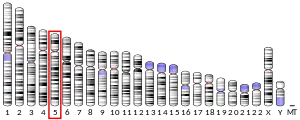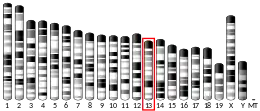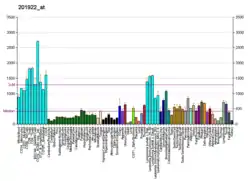TINP1
TGF beta-inducible nuclear protein 1 is a protein that in humans is encoded by the NSA2 gene.[5][6][7]
| NSA2 | |||||||||||||||||||||||||||||||||||||||||||||||||||
|---|---|---|---|---|---|---|---|---|---|---|---|---|---|---|---|---|---|---|---|---|---|---|---|---|---|---|---|---|---|---|---|---|---|---|---|---|---|---|---|---|---|---|---|---|---|---|---|---|---|---|---|
| Identifiers | |||||||||||||||||||||||||||||||||||||||||||||||||||
| Aliases | NSA2, CDK105, HCL-G1, HCLG1, HUSSY29, TINP1, HUSSY-29, ribosome biogenesis homolog, NSA2 ribosome biogenesis factor | ||||||||||||||||||||||||||||||||||||||||||||||||||
| External IDs | OMIM: 612497 MGI: 1913883 HomoloGene: 5844 GeneCards: NSA2 | ||||||||||||||||||||||||||||||||||||||||||||||||||
| |||||||||||||||||||||||||||||||||||||||||||||||||||
| |||||||||||||||||||||||||||||||||||||||||||||||||||
| |||||||||||||||||||||||||||||||||||||||||||||||||||
| |||||||||||||||||||||||||||||||||||||||||||||||||||
| |||||||||||||||||||||||||||||||||||||||||||||||||||
| Wikidata | |||||||||||||||||||||||||||||||||||||||||||||||||||
| |||||||||||||||||||||||||||||||||||||||||||||||||||
References
- GRCh38: Ensembl release 89: ENSG00000164346 - Ensembl, May 2017
- GRCm38: Ensembl release 89: ENSMUSG00000060739 - Ensembl, May 2017
- "Human PubMed Reference:". National Center for Biotechnology Information, U.S. National Library of Medicine.
- "Mouse PubMed Reference:". National Center for Biotechnology Information, U.S. National Library of Medicine.
- Stanchi F, Bertocco E, Toppo S, Dioguardi R, Simionati B, Cannata N, Zimbello R, Lanfranchi G, Valle G (January 2001). "Characterization of 16 novel human genes showing high similarity to yeast sequences". Yeast. 18 (1): 69–80. doi:10.1002/1097-0061(200101)18:1<69::AID-YEA647>3.0.CO;2-H. PMID 11124703. S2CID 21397515.
- Wu X, Ivanova G, Merup M, Jansson M, Stellan B, Grandér D, Zabarovsky E, Gahrton G, Einhorn S (September 1999). "Molecular analysis of the human chromosome 5q13.3 region in patients with hairy cell leukemia and identification of tumor suppressor gene candidates". Genomics. 60 (2): 161–71. doi:10.1006/geno.1999.5911. PMID 10486207.
- "Entrez Gene: TINP1 TGF beta-inducible nuclear protein 1".
Further reading
- Lebreton A, Saveanu C, Decourty L, Jacquier A, Fromont-Racine M (September 2006). "Nsa2 is an unstable, conserved factor required for the maturation of 27 SB pre-rRNAs". The Journal of Biological Chemistry. 281 (37): 27099–108. doi:10.1074/jbc.M602199200. PMID 16861225.
- Andersen JS, Lam YW, Leung AK, Ong SE, Lyon CE, Lamond AI, Mann M (January 2005). "Nucleolar proteome dynamics". Nature. 433 (7021): 77–83. Bibcode:2005Natur.433...77A. doi:10.1038/nature03207. PMID 15635413. S2CID 4344740.
- Scherl A, Couté Y, Déon C, Callé A, Kindbeiter K, Sanchez JC, Greco A, Hochstrasser D, Diaz JJ (November 2002). "Functional proteomic analysis of human nucleolus". Molecular Biology of the Cell. 13 (11): 4100–9. doi:10.1091/mbc.E02-05-0271. PMC 133617. PMID 12429849.
This article is issued from Wikipedia. The text is licensed under Creative Commons - Attribution - Sharealike. Additional terms may apply for the media files.




